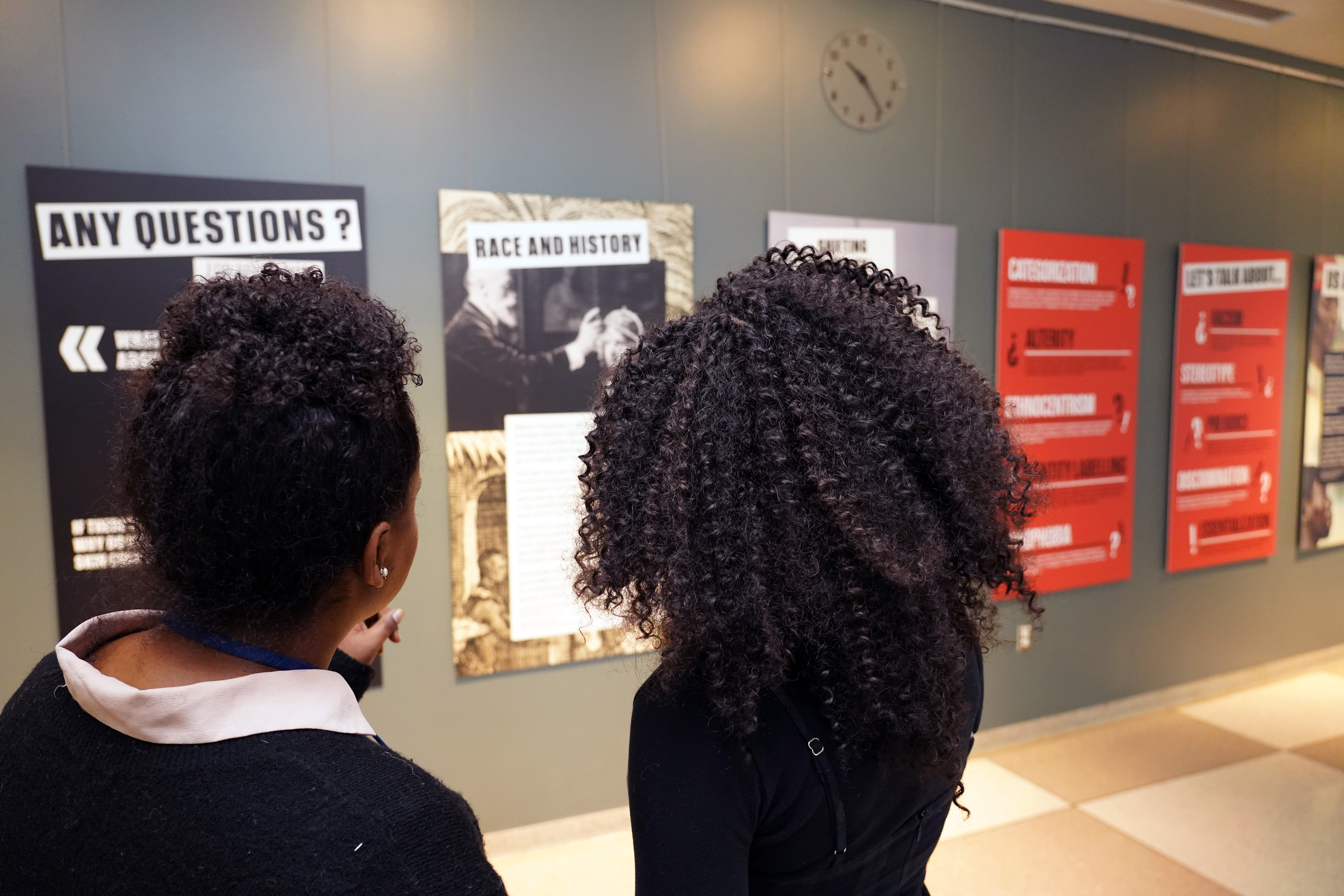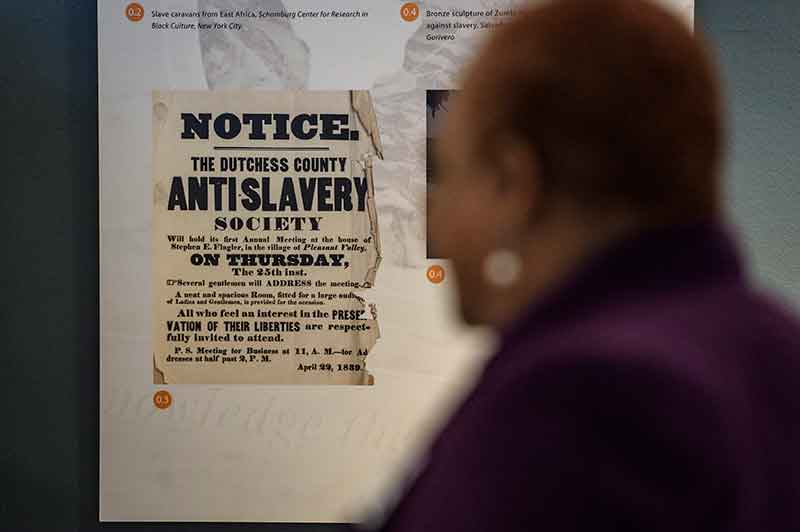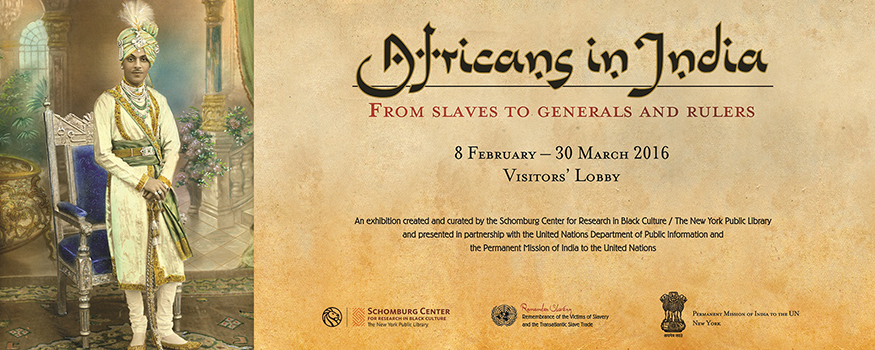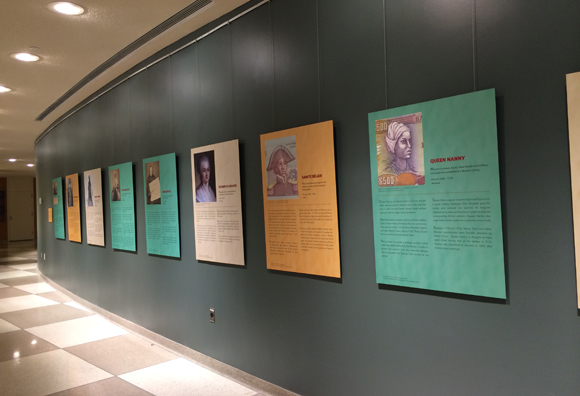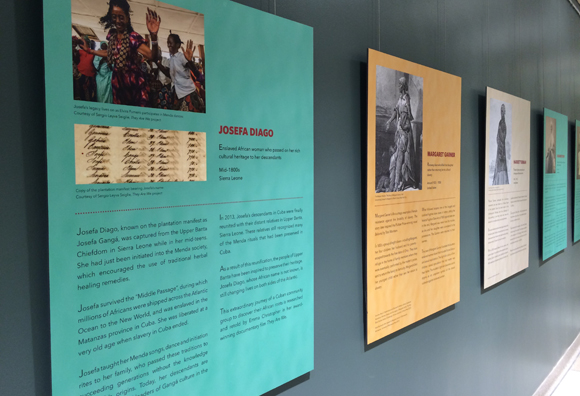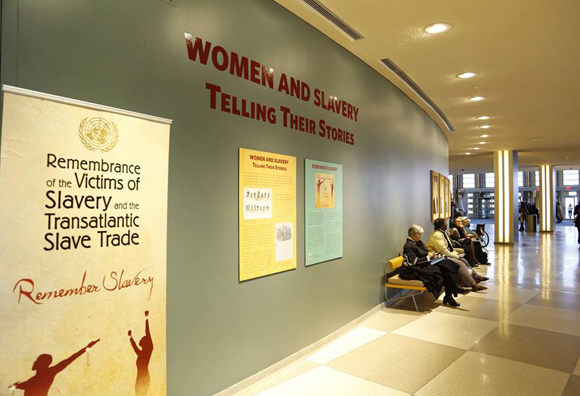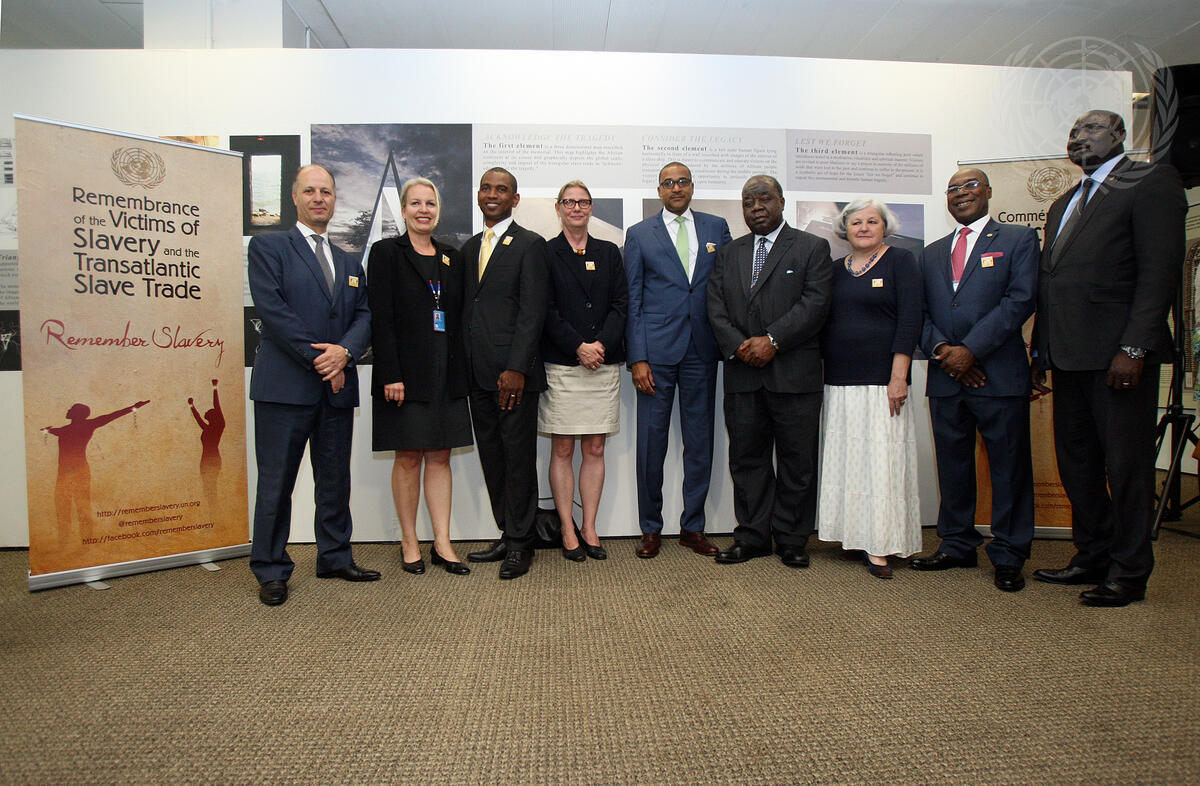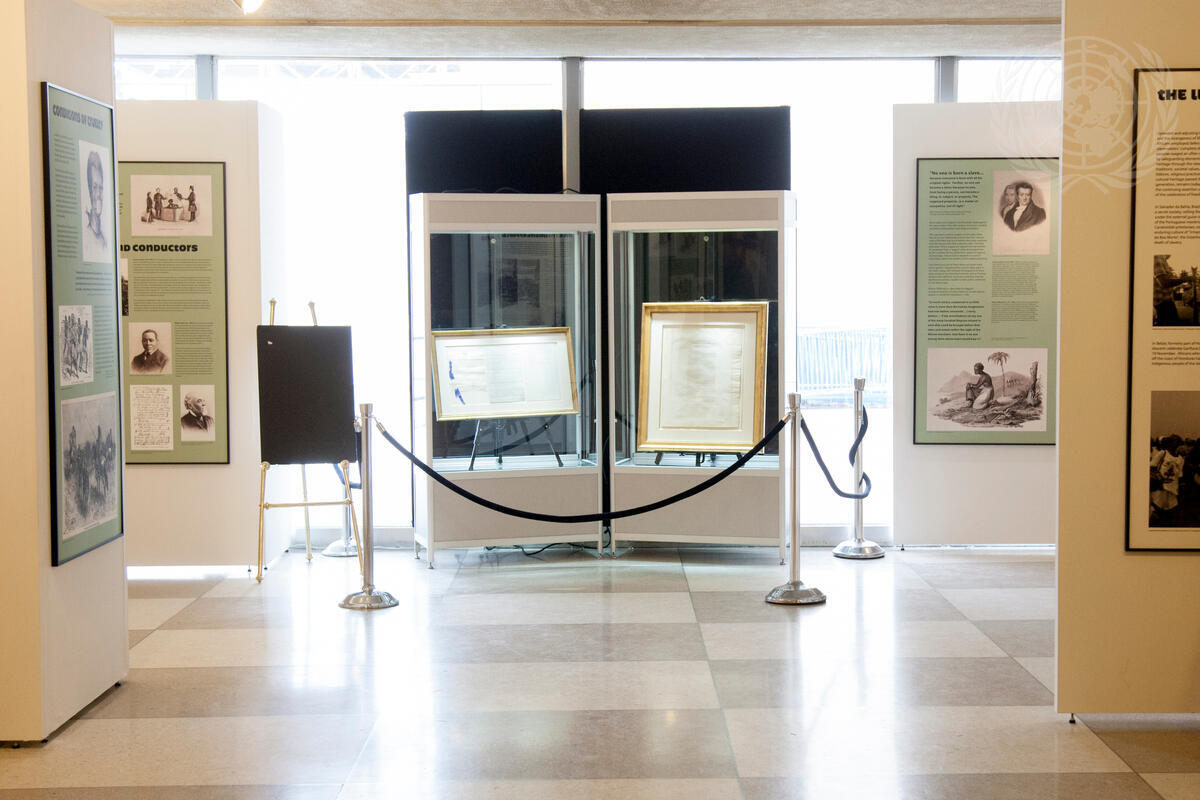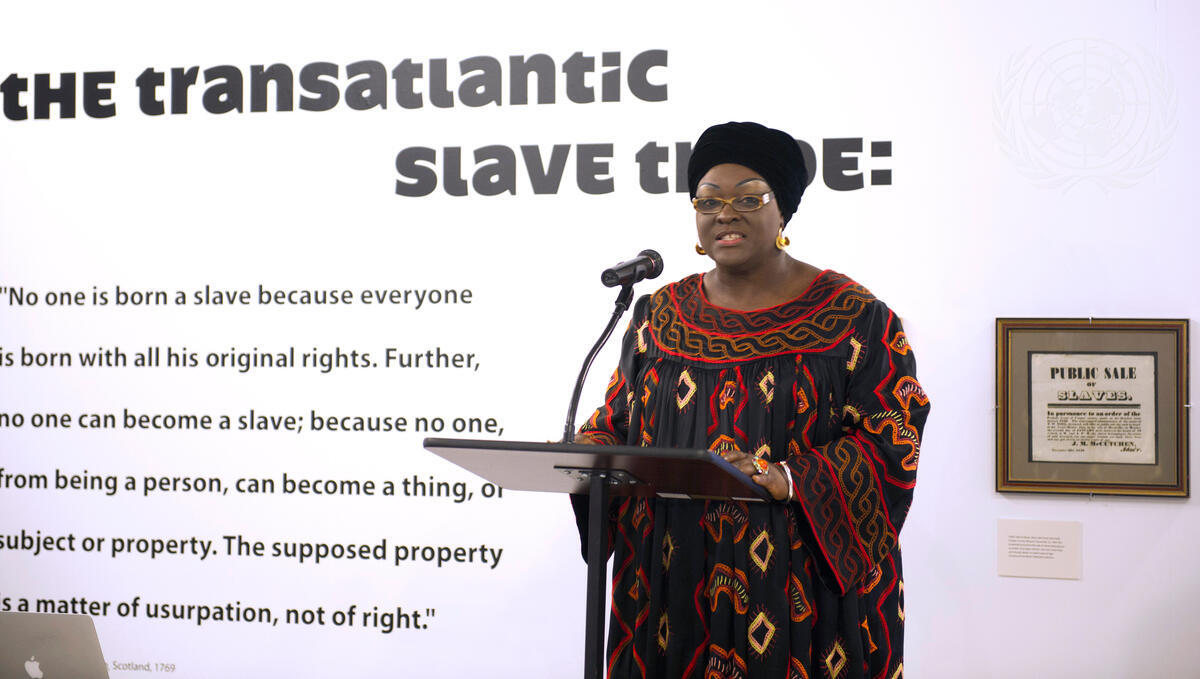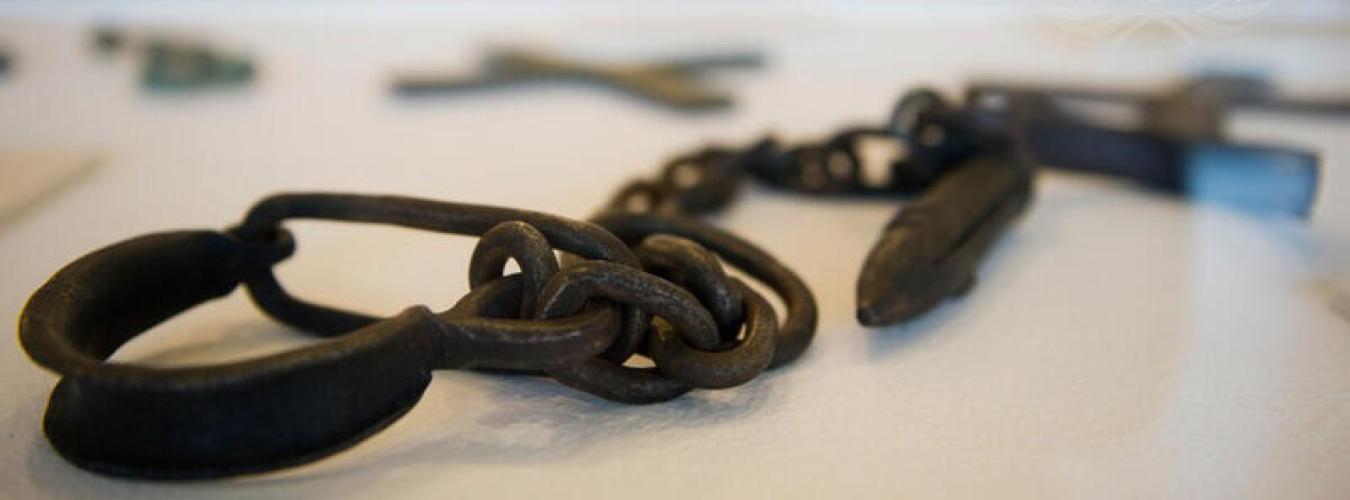
Exhibitions
The Outreach Programme on the Transatlantic Slave Trade and Slavery helps to facilitate the organization of temporary exhibitions on related topics every year during the week of 25 March, which marks the International Day of Remembrance of the Victims of Slavery and the Transatlantic Slave Trade.
2024 2023 2022 2020 2019 2018 2017 2016 2015 2014 2013 2012
2024
19 March 2024
Exhibit on enslavement in South Africa opens at UN Headquarters
The United Nations Outreach Programme on the Transatlantic Slave Trade and Slavery in collaboration with the Iziko Museums of South Africa displayed an adaptation of the exhibit “Who were the enslaved? Commemorating lives under enslavement at the Cape of Good Hope” from 19 March until 14 June 2024. Originally displayed at the Iziko Slave Lodge in Cape Town in 2022, the exhibit examines slavery in South Africa and highlights stories of individuals enslaved at the Slave Lodge.

DGC/Catharine Smith, 5 March 2024

DGC/Catharine Smith, 5 March 2024
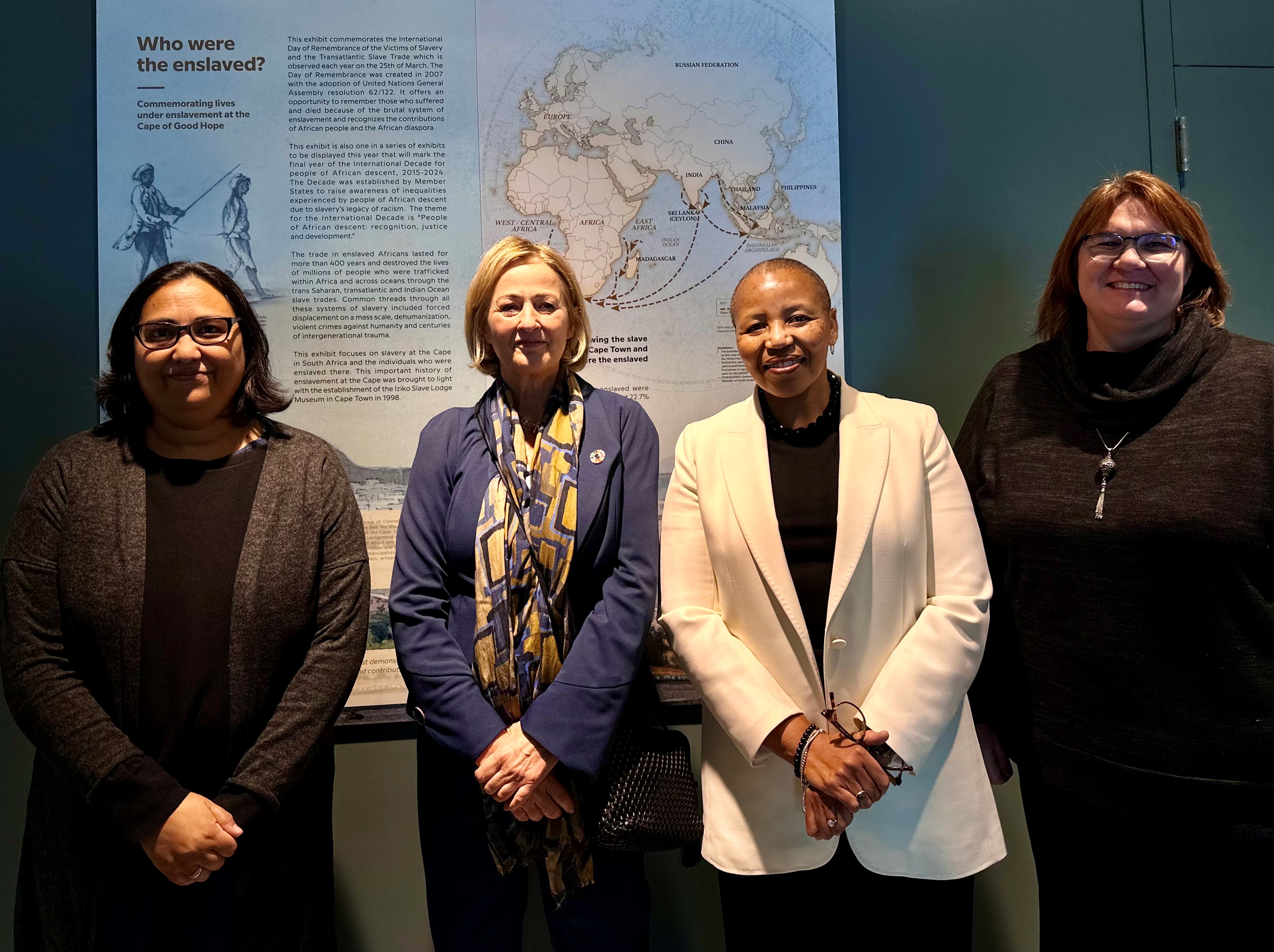
From left to right: Iziko Museums Exhibits Curator Shanaz Galaant; H.E. Ms. Yoka Brandt,
Permanent Representative of the Netherlands to the UN; H.E. Ms. Mathu Joyini,
Permanent Representative of South Africa to the UN; Iziko Museums Chief Curator Wendy Black
DGC/Catharine Smith, 5 March 2024
25 March - 28 March 2024
New exhibit highlights tragic “Ibo Landing” history
The United Nations Outreach Programme on the Transatlantic Slave Trade and Slavery supported the United Nations Population Fund (UNFPA) on the display of their powerful exhibit entitled “Ibo Landing”. The Ibo, also referred to as Igbo, are one of the largest ethnic groups in West Africa. In 1803, a group of enslaved people from this region committed one of history’s most grievous acts of resistance in defiance of enslavement. This exhibit captured the sorrow and horrors of this historic event that took place in the US state of Georgia, through original drawings by Jamaican-American artist Donovan Nelson. The exhibit was on display at United Nations Headquarters in New York.

Artist Donovan Nelson with UN officials at the opening:
(L-R) UNFPA Programme Adviser Patrica Da Silva, UNFPA Executive Director
Dr. Natalia Kanem, Under-Secretary-General for Global Communications Melissa
Fleming, artist Donovan Nelson, Permanent Observer of the African Union to the UN
Fatima K. Mohammed, Chef de Cabinet Courtenay Rattray
UNFPA/Yuntong Man, 25 March 2024
20 May 2024
New exhibit honours freedom fighters in Haiti and United States
A new exhibit, “Haiti-Louisiana: Tides of Freedom”, opened at United Nations Headquarters in New York. Organized by the Permanent Mission of Haiti to the United Nations and the Office of the Permanent Observer for the International Organization of la Francophonie to the United Nations, the exhibit honours the courage of those who fought for freedom in the 1791-1804 Haitian Revolution and the 1811 German Coast Uprising in the Territory of Orleans, the largest revolt of enslaved peoples in US history. The exhibit features artwork by seven artists that convey a universal message of freedom and resilience.

Exhibit "Haiti-Louisiana: Tides of Freedom"
DGC
2023
“Slavery: Ten True Stories of Dutch Colonial Slavery”
Exhibition "Slavery: Ten True Stories of Dutch Colonial Slavery" on display at UN Headquarters
The United Nations Outreach Programme on the Transatlantic Slave Trade and Slavery in collaboration with the Rijksmuseum and supported by the Permanent Mission of the Kingdom of the Netherlands to the United Nations and the Consulate General of the Kingdom of the Netherlands in New York hosted the exhibition entitled "Slavery: Ten True Stories of Dutch Colonial Slavery" which was on display in the United Nations Visitors' Lobby from 27 February to 30 March 2023. Originally curated and displayed in 2021 by Amsterdam’s Rijksmuseum, the Netherlands’ national museum of art and history. The Ten True Stories exhibition was focusing on slavery in the Dutch colonial era, from the 17th to the 19th century – in Brazil, Suriname and the Caribbean, as well as in South Africa, Asia and the Netherlands itself. It presented ten true personal stories of people who were enslaved, people who profited from the system of slavery, and people who raised their voices against it. Their accounts came to life by scanning corresponding QR codes to listen to a pre-recorded audio of people living in the Netherlands who have a personal connection with the story. In New York, the ten stories integral to the original Slavery exhibition was presented around one single artifact: wooden foot stocks known as a ‘tronco’ (from the Portuguese for ‘tree trunk’). Several enslaved people would be forced to have their ankles clamped in the holes to constrain them –to subject them to corporal punishment and prevent from escaping. The foot stocks symbolize the more than one million people who were shipped in from around the world and forced to work, whether on plantations, as craftspeople, in mines, in transportation or on military expeditions. The poster version of the exhibition is available for display until 31 December 2024 at other UN offices worldwide.
In response to the display of the exhibit, Secretary-General of the United Nations, António Guterres, remarked:
“The legacy of centuries of enslavement, exploitation, and colonial rule reverberates to this day. We must learn and teach the history of slavery:
the crime against humanity; the unprecedented mass human trafficking; the unspeakable human rights violations. Behind the facts and figures are millions of human stories of
untold suffering and pain. But also, stories of awe-inspiring resilience, courage and defiance against the cruelty of oppressors.
This powerful exhibition calls on us all to put an end to racism and injustice In our own time and make inclusive societies based on dignity and rights a reality everywhere.”
2022
“Us and Them: From Prejudice to Racism”
Exhibit on racism opens at UN Headquarters
An exhibit entitled "Us and Them: From Prejudice to Racism" was re-displayed in the Visitors Lobby at United Nations Headquarters from 16 February until 5 April. Organized in partnership with the United Nations Educational, Scientific and Cultural Organization (UNESCO) and the Musée de l’Homme in Paris, France, the exhibit examines the science behind “race”; how racism flourished during the transatlantic slave trade; and how slavery's legacy of racism can be fought at multiple levels.
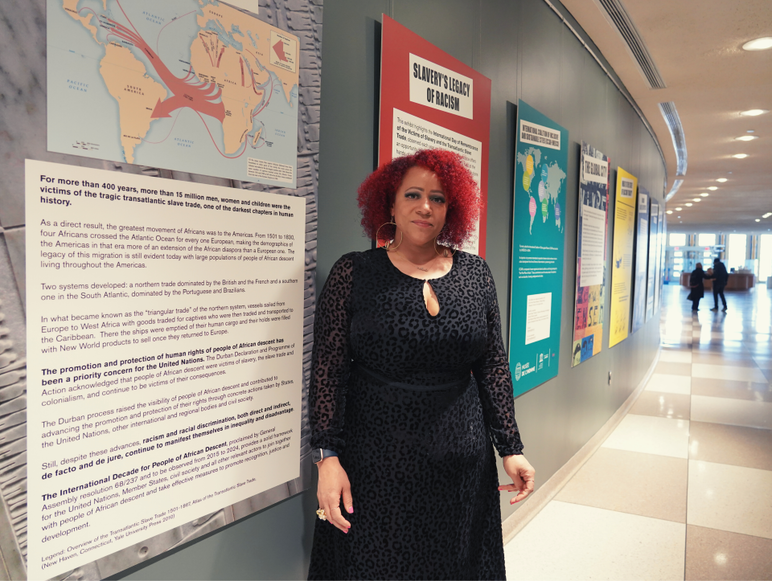
Nikole Hannah-Jones, creator of The New York Times’ 1619 Project
visits "Us and Them: From Prejudice to Racism" exhibit, 29 March 2022
Photo: DGC/Xiaoyu Yang
“Ten true stories of Dutch colonial slavery”
Exhibit in Mexico City sheds light on Dutch colonial slavery and its legacy of racism
In support of UNESCO’s Global Forum against Racism and Discrimination, which was held in Mexico City on 28 and 29 November, the United Nations Outreach Programme on the Transatlantic Slave Trade and Slavery – in collaboration with the Rijksmuseum and the United Nations Information Centre in Mexico City – displayed a poster version of the exhibit “Ten true stories of Dutch colonial slavery” at Los Pinos cultural centre. The exhibit showcased ten true stories of people who were enslaved, profited from the system and revolted against it. The stories form part of our global history and help us to better understand the legacy of slavery in today’s societies. Jayashri Wyatt, Chief of the UN Department of Global Communications’ Education Outreach Section, spoke at the opening of the exhibit. The exhibit will run at Los Pinos until 9 January 2023.
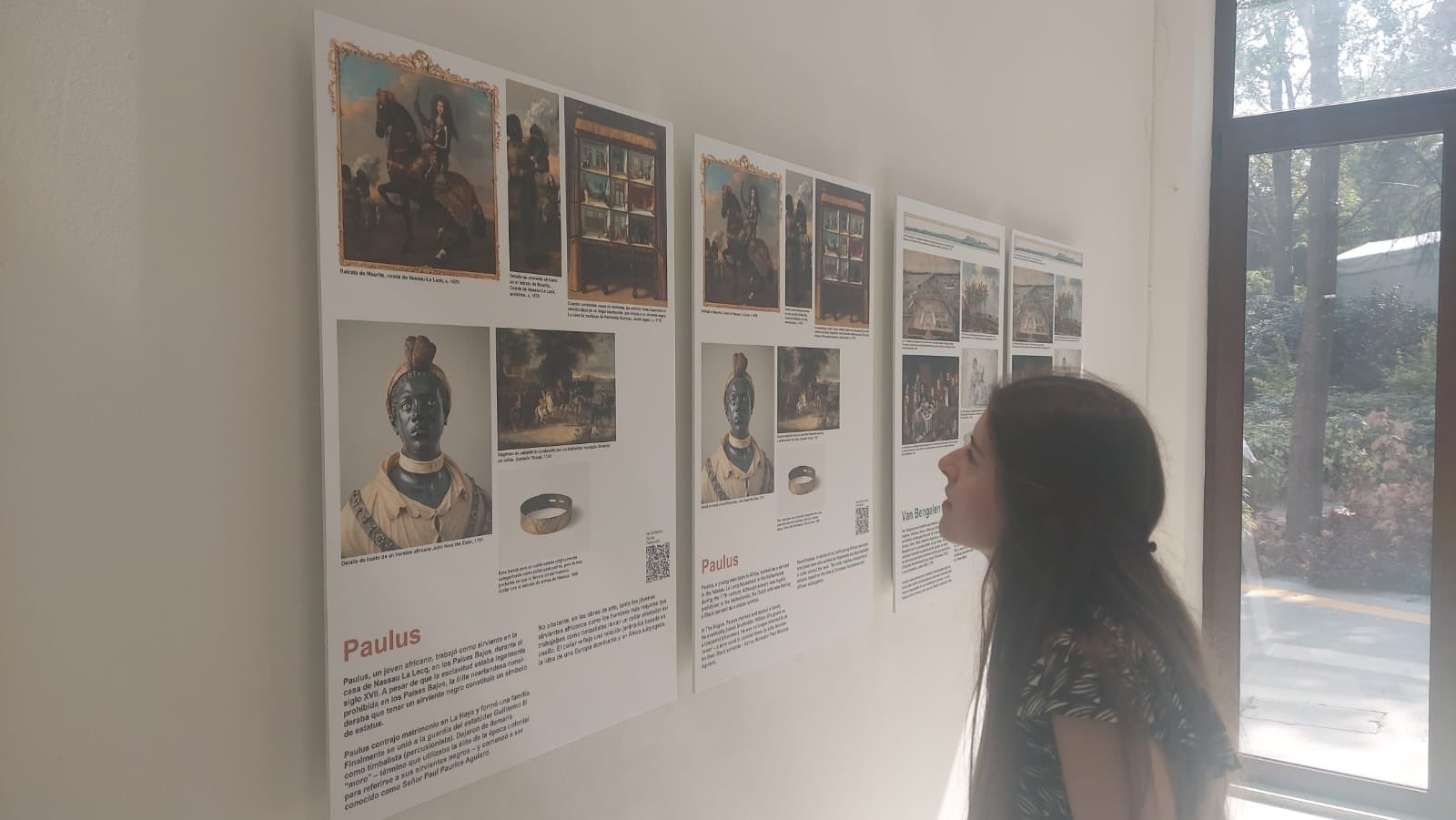
Poster version of the exhibit “Ten true stories of Dutch colonial slavery”
on display at Los Pinos cultural centre in Mexico City.
Photo: DGC/UNIC Mexico City/Mariana Castro
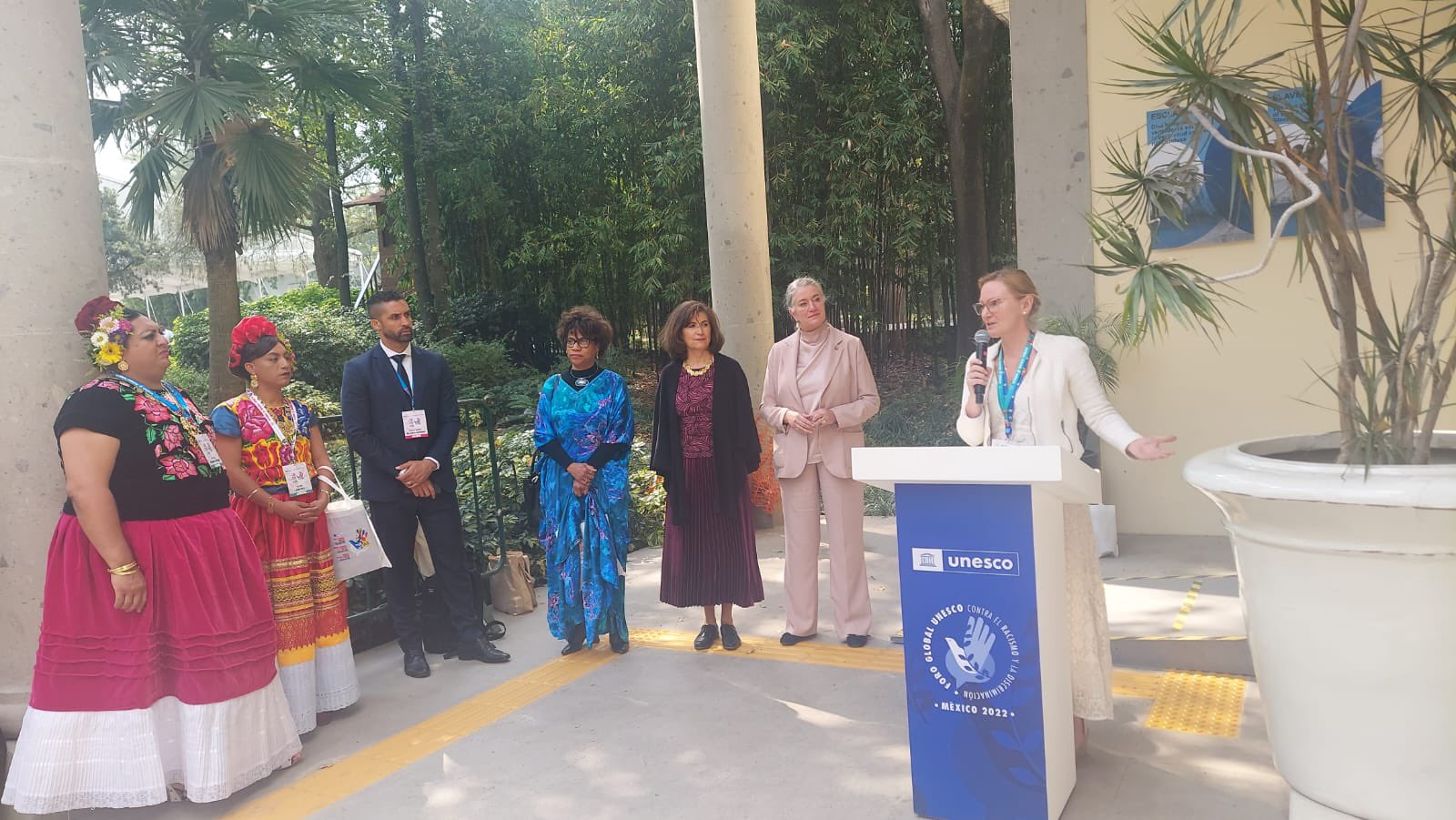
Jayashri Wyatt, Chief of UN Education Outreach Section spoke
at the opening of the exhibit. 28 November 2022.
Photo: DGC/UNIC Mexico City/Mariana Castro
2020 - 2022
“Us and Them: From Prejudice to Racism”
United Nations hosts exhibit on racism and transatlantic slave trade
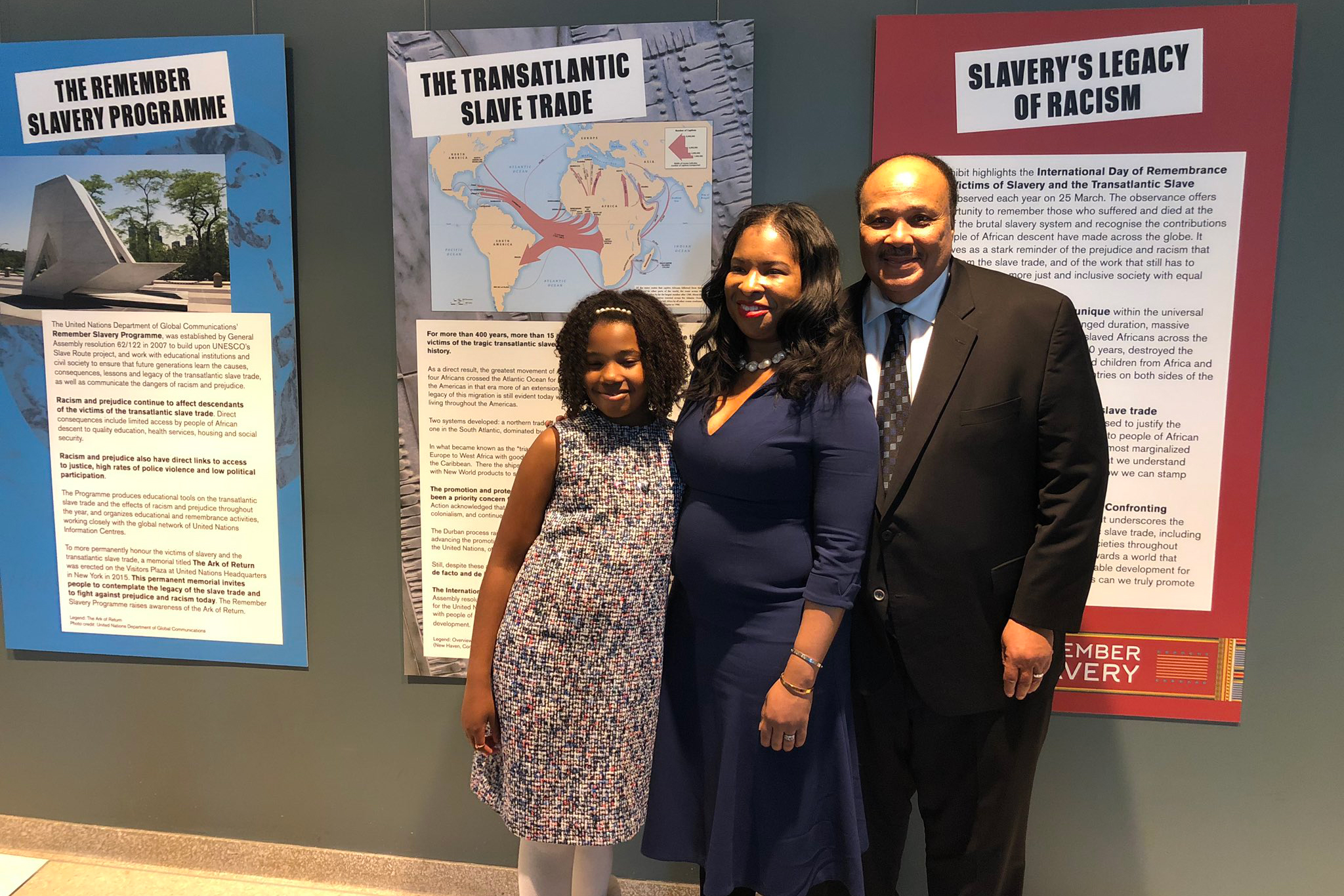
An exhibit entitled “Us and Them: From Prejudice to Racism” was on display in the United Nations Visitors Lobby in New York from 21 February until 4 May 2020. It is currently being re-displayed at United Nations Headquarters in New York from 16 February to 5 April 2022.
The exhibit highlights the International Day of Remembrance of the Victims of Slavery and the Transatlantic Slave Trade, which is observed annually on 25 March.
The exhibit examines the science behind the concept of race; shows how racism flourished during the transatlantic
slave trade and continues to divide societies today; and teaches that racism is a social construct that is not inevitable
and can be fought at multiple levels.
Produced by the French National Museum of Natural History in cooperation with the United Nations Educational,
Scientific and Cultural Organization (UNESCO), the exhibit uses anthropology, biology, economics, history and sociology,
to explore this pertinent and timely topic.
In addition to showing the exhibit in English at United Nations Headquarters, the United Nations Outreach Programme on the Transatlantic Slave Trade and Slavery created traveling versions in Arabic, French, Kiswahili, Portuguese, Russian and Spanish, for use by the global network of United Nations Information Centres and Resident Coordinator Offices in their activities to commemorate the International Day.
Information Centres and Resident Coordinator Offices in their activities to commemorate the International Day.
Photo: Martin Luther King III, human rights advocate and son of US civil rights leader Martin Luther King, Jr., visited the exhibit on 4 March 2020, with his wife, Arndrea Waters King, and daughter, Yolanda Renee.
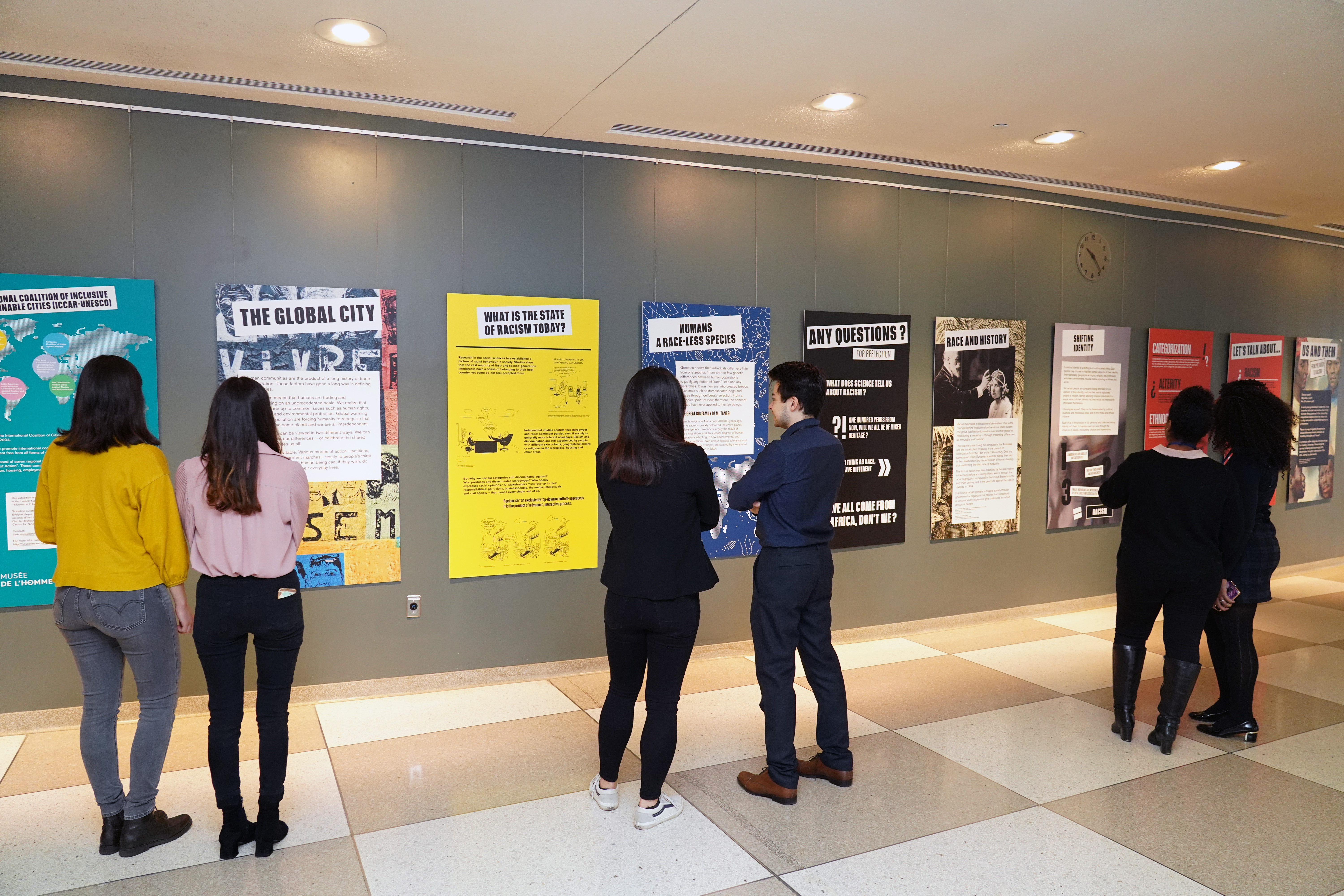
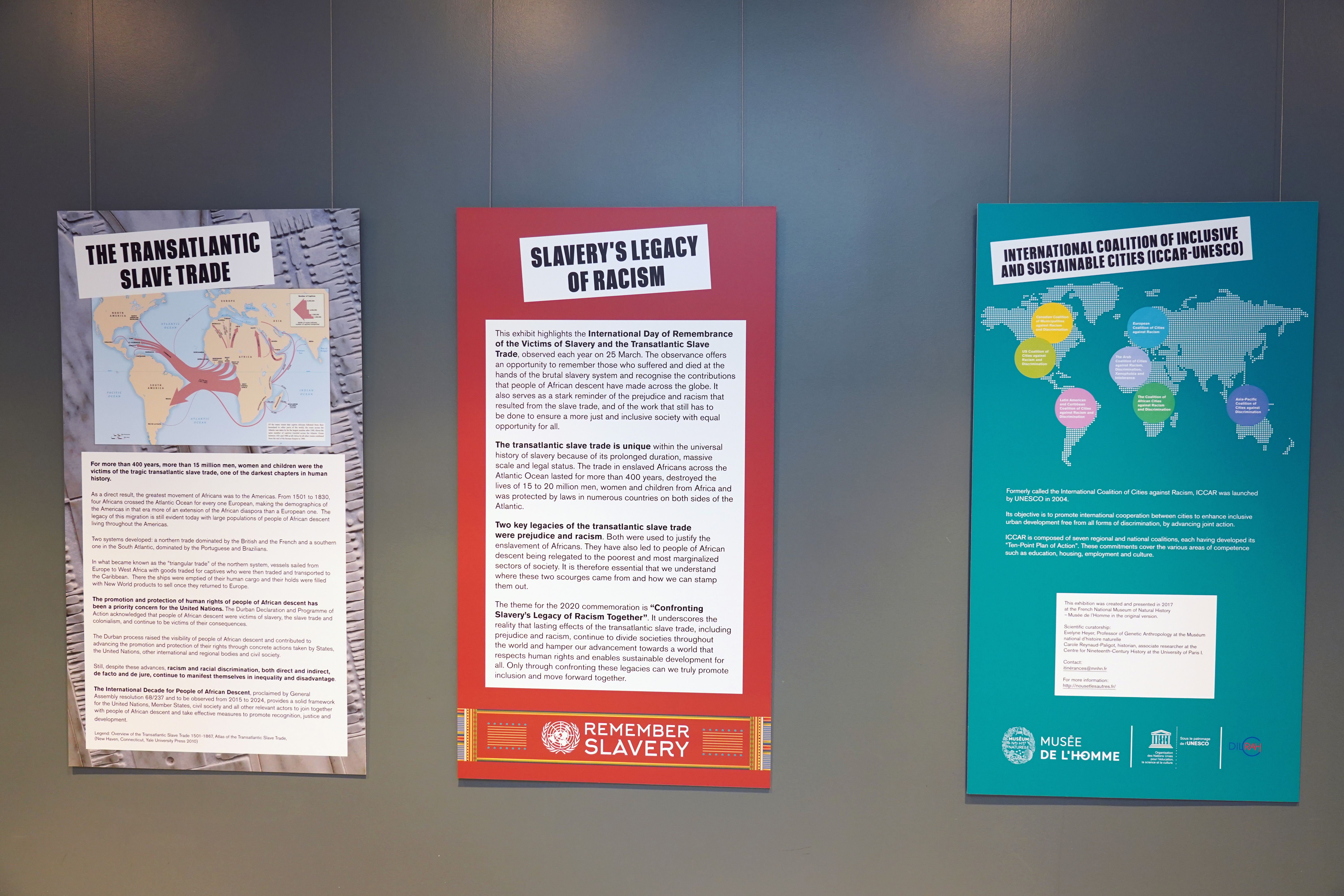
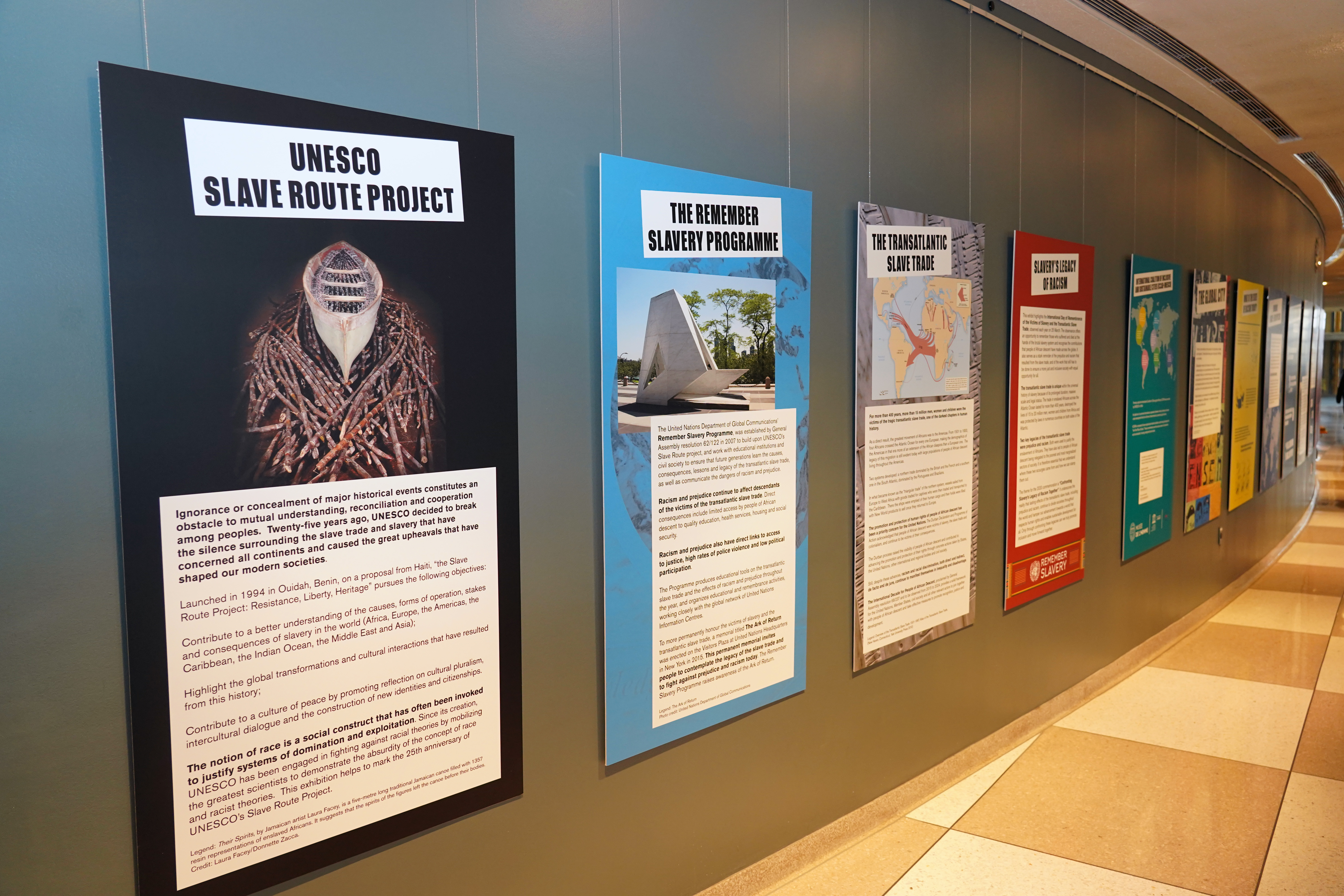
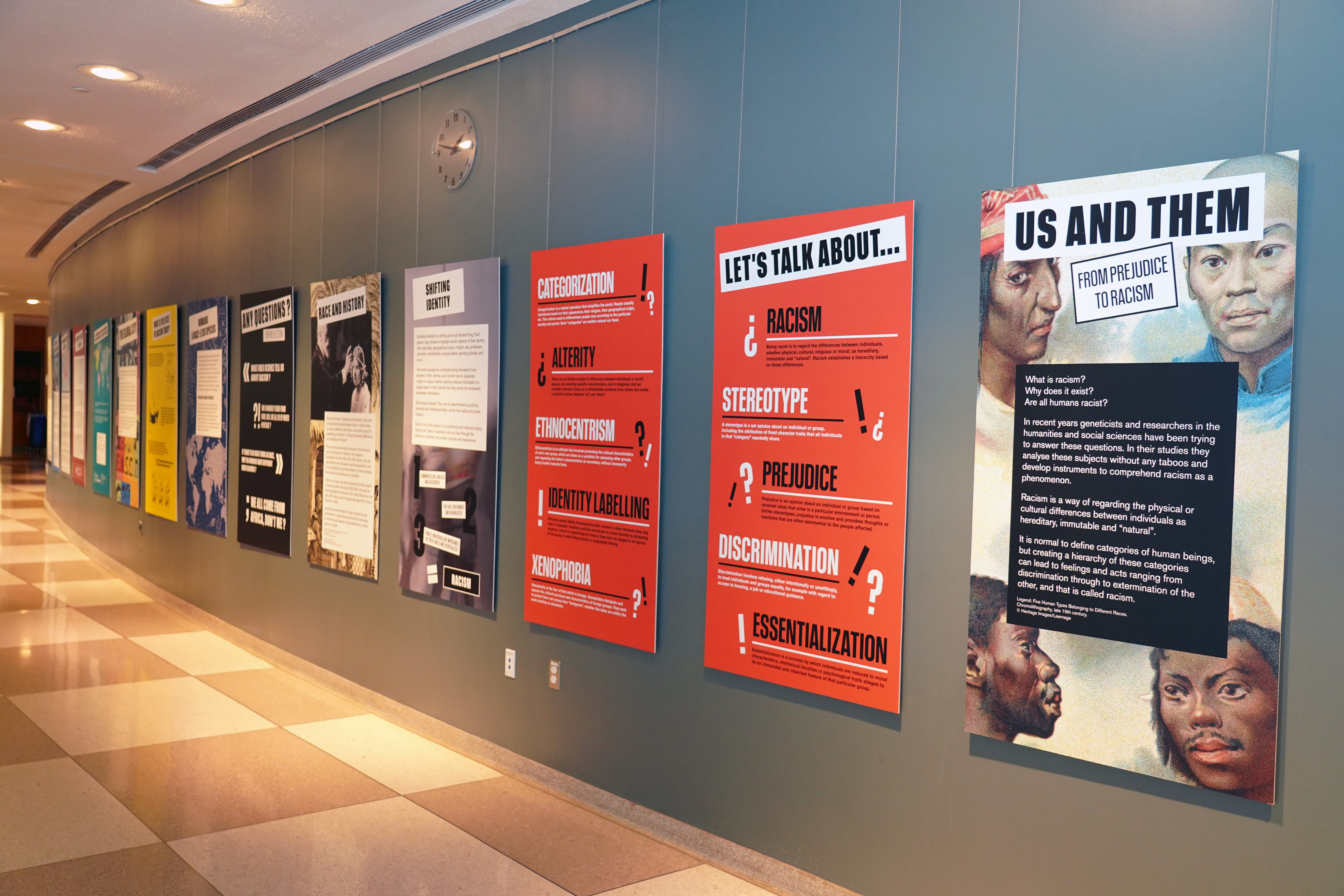
2019
"From Africa to the New World - Slavery in New York"
UN Remember Slavery Programme opens "Slavery in New York" exhibit
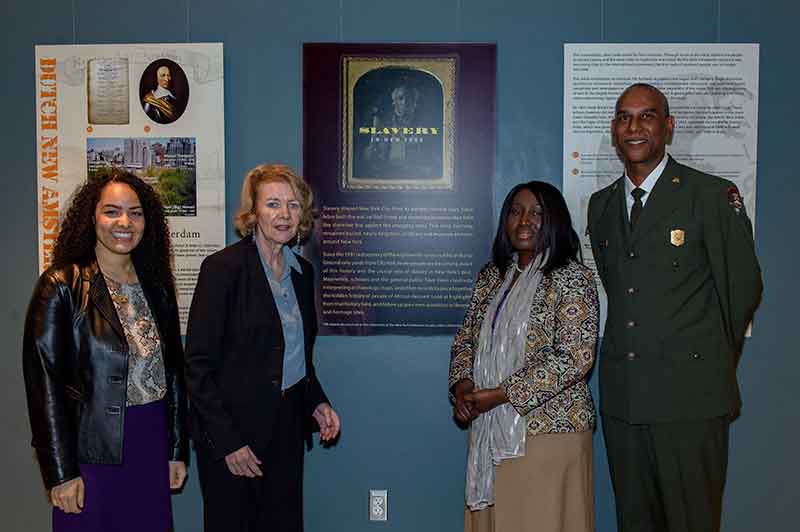
Photo: From left to right: Dominique Jean-Louis, Curator, New-York Historical Society; Alison Smale, UN Under-Secretary-General for Global Communications; Louise Bailey, Senior Political Advisor, African Union Mission to the UN; Michael Frazier, Historian, African Burial Ground National Monument. © UN Photo/Loey Felipe
21 March 2019 - Diplomats, visitors to the United Nations, and staff members gathered in the Visitors Lobby of the Secretariat Building at United Nations Headquarters today for the opening of the exhibit ”From Africa to the New World: Slavery in New York”. The opening was one of several events organized by the United Nations Remember Slavery Programme to mark the International Day of Remembrance of the Victims of Slavery and the Transatlantic Slave Trade. The theme of this year's commemoration is "Remember Slavery: The Power of the Arts for Justice".
Opening the exhibit was Alison Smale, the United Nations' Under-Secretary-General for Global Communications, who emphasized that the transatlantic slave trade was one of the gravest crimes ever committed. “From the early 1400s to the middle of the 1800s, an estimated 17 million Africans were forcibly displaced from Africa to the Americas”, she said. “The legacies of this shameful era include racism, which continues to harm our societies today.”
Speaking on behalf of the Permanent Mission of the African Union to the United Nations was Senior Political Affairs Officer Louise Bailey. She noted that the exhibit was very timely because the first enslaved African set foot in Virginia 400 years ago. She added, "The African diaspora living in the five boroughs continues to play an important role in the growth and development of New York."
Slavery in New York City is a little-known chapter of the dark saga of the transatlantic slave trade. Both free and enslaved people lived side by side, which created unique circumstances and allowed the African community to push for freedom.
The rediscovery of the African Burial Ground changed the intellectual paradigm of enslavement for New York. Speaking on behalf of the African Burial Ground National Monument, historian Michael Frazier said, "By 1703, New York had the largest colonial slave population outside of Charleston, South Carolina, and by 1756, Africans made up 25% of the population of the city". The National Monument contains human skeletal remains that date from 1627 to 1790, and is the final resting place of between 10 to 15,000 human skeletons. Each grave tells an interesting story.
It is noted in the exhibit that the African Burial Ground was one of the few places where enslaved Africans could find tranquility. The African community living in New York City was allowed to practice traditional African burial ceremonies there. It was one of the few places where enslaved Africans could escape surveillance because white people would never venture there.
The exhibit was created by the New-York Historical Society. Representing the museum was historian Dominique Jean-Louis who said the New-York Historical Society had been telling the history of the city since 1804. She said, "Among all of the stories, telling the story of slavery in New York was one that stood out." Few people know that 42% of the residents of New York City owned slaves, or that Wall Street is named after a wall built in 1703 by enslaved Africans. She concluded, "New York was shaped by the brutal realities of the slave trade. Let us hope that bringing justice will come with confronting a difficult past."
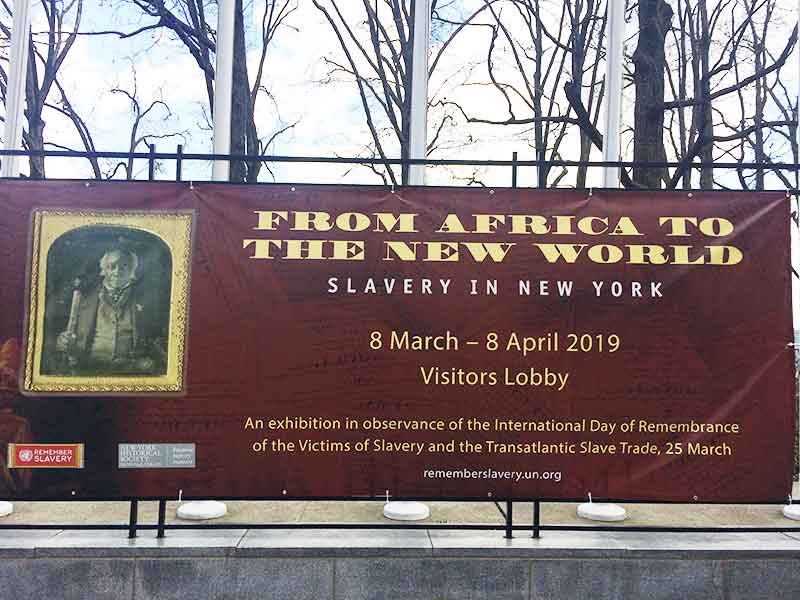
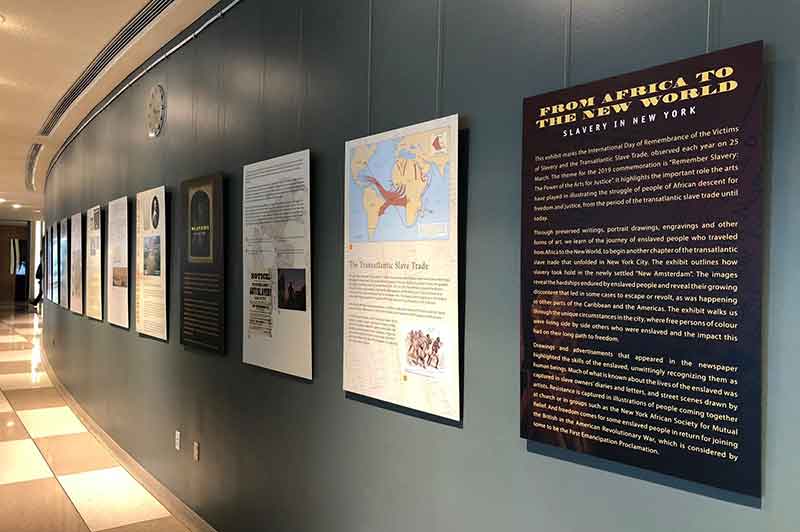
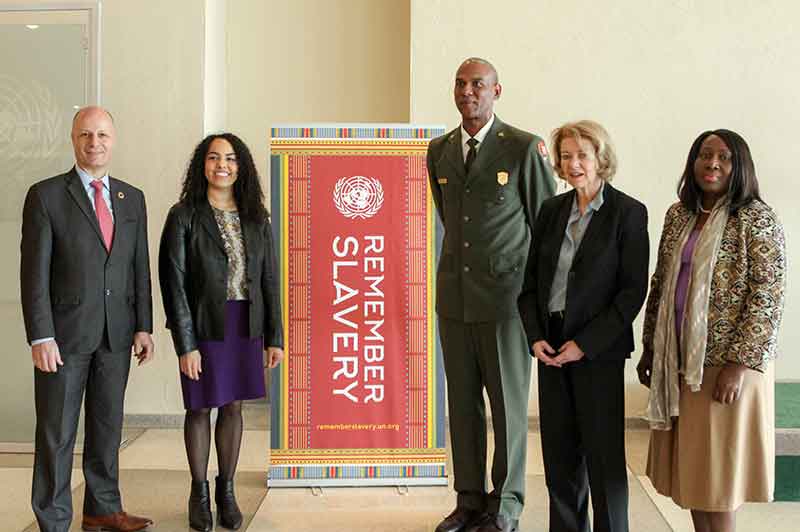
From left to right: Maher Nasser, Director, Outreach Division, UN Department of Global Communications; Dominique Jean-Louis, Curator, New-York Historical Society; Michael Frazier, Historian, African Burial Ground National Monument; Alison Smale, UN Under-Secretary-General for Global Communications; Louise Bailey, Senior Political Advisor, Permanent Observer Mission of the African Union to the UN. © Bo Li

From left to right: Dominique Jean-Louis, Curator, New-York Historical Society; Alison Smale, UN Under-Secretary-General for Global Communications; Michael Frazier, Historian, African Burial Ground National Monument; H.E. A. Missouri Sherman-Peter, Permanent Observer of the Caribbean Community (CARICOM) to the UN. © Bo Li
© UN Photo/Loey Felipe
2018
"Remember Slavery: Say Out Loud"
An exhibition titled “Remember Slavery: Say It Loud” was on display from 5 to 28 March 2018, in the Visitors Lobby at United Nations Headquarters in New York.
Presented in collaboration with the National Organization of Minority Architects, the exhibit highlighted the work of 10 male and 11 female African diasporan architects, who through their perseverance and creative talent, gained recognition in this elite profession. Their unique perspective enabled them to have a voice and an impact on the way public spaces are presented and used.
The exhibit was organized as part of the commemoration of the 2018 International Day of Remembrance of the Victims of Slavery and the Transatlantic Slave Trade, under the theme “Remember Slavery: Triumphs and Struggles for Freedom and Equality”. The theme celebrated the gains of people of African descent from slavery to the present. It also acknowledged the challenges that were overcome in the movement towards freedom and equality in all professions.
2017
"A Legacy of Black Achivement"
Exhibit “A Legacy of Black Achievement,” Special Event Marking International Day of Remembrance of Victims of Slavery, March 2017
An exhibition titled “A Legacy of Black Achievement” was on display in the Visitors’ Lobby of United Nations Headquarters in New York from 8 to 29 March 2017.
Produced by the International Slavery Museum in Liverpool, United Kingdom, and adapted from that institution’s Black Achievers Wall gallery, the exhibition featured 21 notable personalities from various backgrounds, eras, regions and disciplines who paved the way for civil and human rights, as well as recognition and justice for people of African descent in Africa, Europe, the Americas and across the globe.
“A Legacy of Black Achievement” was presented in partnership with the United Nations Department of Public Information’s Remember Slavery Programme, and was on display during the commemorative events associated with the International Day of Remembrance of the Victims of Slavery and the Transatlantic Slave Trade. “This exhibit fits perfectly with the 2017 theme for the International Day of Remembrance of the Victims of Slavery and the Transatlantic Slave Trade, which is ‘Remember Slavery: Recognizing the Legacy and Contributions of People of African Descent’,” said Maher Nasser, Acting UN Under-Secretary-General for Global Communications. “It reminds us of the ways in which the people of Africa and their descendants have helped to shape societies across the globe,” he added. “In a world where racism and prejudice have not yet been stamped out, it is crucial that we remember and honour such contributions.”
Richard Benjamin, Head of the International Slavery Museum, said: “The International Slavery Museum is incredibly pleased to have collaborated with the United Nations and the Remember Slavery Programme on this marvellous and timely exhibition. The Black Achievers Wall in Liverpool is one of our most important displays as it highlights the many forms of achievement — often in the face of great adversity and difficulties — that have taken place both during and since the transatlantic slave trade era. These remarkable feats have an enormously positive effect on visitors to the Museum, particularly younger visitors, and I’m sure this will also be the case in New York.”
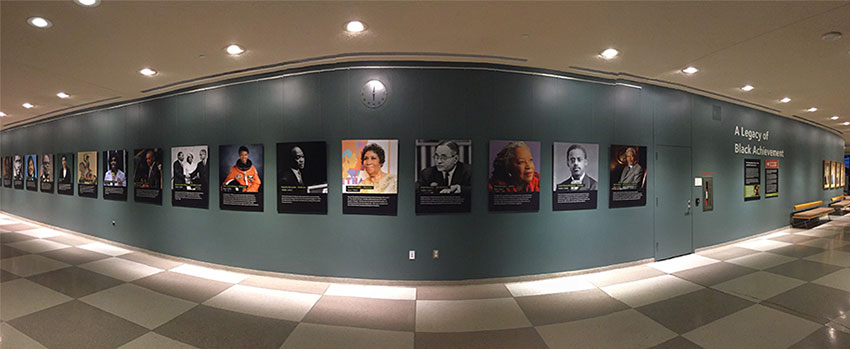
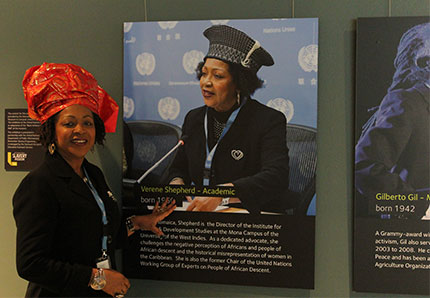
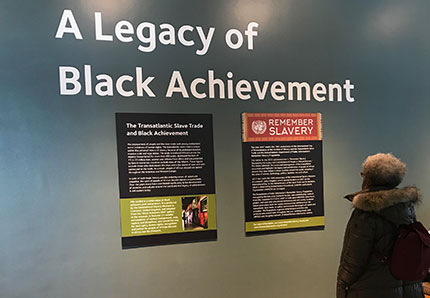 .
.
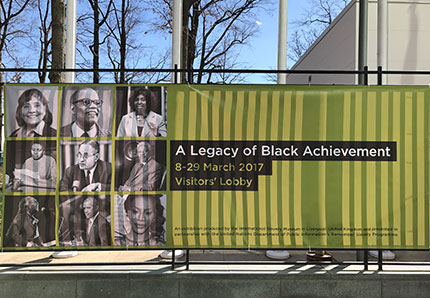
2016
Africans in India: From Slaves to Generals and Rulers
Exhibit: “Africans in India: From Slaves to Generals and Rulers”, Opening of Exhibit on Africans in India, March 2016
Africans in India: From Slaves to Generals and Rulers
The exhibition was on display at United Nations Headquarters in New York from 8 February to 30 March 2016. It was created by The Schomburg Center for Research in Black Culture of The New York Public Library. The curators are Dr. Sylviane A. Diouf, Director of the Lapidus Center for the Historical Analysis of Transatlantic Slavery at The Schomburg Center, and Dr. Kenneth X. Robbins, collector and expert in Indian art.
The exhibit tells the fascinating history of enslaved East Africans in India, known as Sidis and Habshis, who rose to positions of military and political authority. Through colourful photographs and texts, the exhibit conveys that their success was also a testimony of the open-mindedness of Indian society in which they were a small religious and ethnic minority, originally of low status. It also sheds light on the slave trade in the Indian Ocean and the history of Africa and its Diaspora in India.
The Remember Slavery Programme produced a travelling version of the exhibition in Arabic, Dutch, English, French, Hindi, Portuguese and Spanish, for display by United Nations Information Centres around the world in observance of the International Day of Remembrance of the Victims of Slavery and the Transatlantic Slave Trade.
In total, the exhibit was displayed in 19 countries.
2015
Women and Slavery: Telling Their Stories
“Women and Slavery: Telling Their Stories” - UN Slavery Remembrance Day Concert, "Legacy of 30 Million Untold Stories", 2011
“Women and Slavery: Telling Their Stories” – an exhibition to mark the International Day of Remembrance of the Victims of Slavery and the Transatlantic Slave Trade – was on display in the United Nations Visitors’ Lobby in New York from 12 March to 9 April 2015.
The exhibition featured the stories of enslaved women who endured the harsh conditions of forced labour and sexual exploitation, yet found the courage to fight for freedom. These women also succeeded in transmitting their African culture and heritage to their descendants, despite the many abuses that they had to bear. In addition, it shone a light on free women who fought for the abolition of the slavery system.
This exhibition was produced by the Remember Slavery Programme in partnership with the Memorial to the Abolition of Slavery in Nantes, France, which published an extensive account of women and slavery in its exhibition "Dix Femmes Puissantes".
"Women and Slavery: Telling Their Stories” was produced in English, French, Portuguese and Spanish, and was displayed in 12 countries by the United Nations information centres.
Resources
- 11 March 2015 - Note to correspondents ‘Women and Slavery: Telling Their Stories’ an Exhibition on Transatlantic Slave Trade Opens at United Nations
- Panels from the exhibit: [English] [Français] [Español] [Português]
Statements delivered on the occasion of the opening of the exhibit on 12 March 2015
- Welcoming remarks by Master of Ceremonies, Ms. Cristina Gallach, Under-Secretary General for Communications and Public Information
- Remarks by H.E. Ambassador Ms. Sherman-Peter, Permanent Observer of CARICOM to the United Nations
- Remarks by Mrs. Louise Sharene Bailey, Senior Political Officer, Officer-in-Charge of the Permanent Observer Mission of the African Union to the United Nations
- Remarks by Ms. Michele Mitchell, Associate Professor of History at New York University
2014
"Victory over Slavery: Haiti and Beyond"
Opening of Photo Exhibit “Victory over Slavery”
Victory Over Slavery: Haiti and beyond is on display at United Nations Headquarters in New York until September 2014.
With an overview of the Transatlantic Slave Trade as a backdrop, the exhibit focuses on the slaves’ struggle for independence in Haiti. Their courage and sacrifice led not only to Haiti's independence, but also to the establishment of the first nation founded as a result of the uprising of enslaved men and women, in 1804.
The exhibition also showcases the design of the Permanent Memorial to Honour the Victims of Slavery and the Transatlantic Slave Trade, which will be erected on United Nations ground in New York early 2015. It will stand as a constant reminder of the courage of slaves, abolitionists and unsung heroes who helped to end slavery.
The exhibit is presented by the United Nations Remembrance Programme on the Victims of Slavery and the Transatlantic Slave Trade (Outreach Division, Department of Public Information) in partnership with the Nantes Memorial to the Abolition of Slavery in France, and architect Rodney Leon, the designer of the Permanent Memorial to Honour the Victims of Slavery and the Transatlantic Slave Trade.
It will remain on display at the United Nations Visitor Centre in New York until 14 September 2014. UN guided tour tickets are necessary for entry during the week. Free walk-in during week-ends.
2013
"Forever Free: Celebrating Emancipation"
Original Signed Copy of Emancipation Proclamation at UNHQ for Slavery Exhibit
The exhibition "Forever Free: Celebrating Emancipation" is comprised of panels retracing the history of the Transatlantic Slave Trade, presenting heroes and activists, the fight for emancipation, and the legacy of slavery today. It is presented in connection with the observance of the International Day of Remembrance of the Victims of Slavery and the Transatlantic Slave Trade, 25 March, in accordance with General Assembly resolution 62/122 of 17 December 2007.
A copy of the Emancipation Proclamation, signed by President Abraham Lincoln and Secretary of State William Seward, along with a signed copy of the Thirteenth Amendment to the United States Constitution was also on display during the commemorative week, 18 - 25 March.
2012
"Honouring the Heroes, Resisters and Survivors"
Multimedia Exhibit on Transatlantic Slave Trade Opens at UNHQ
The exhibition "Honouring the Heroes, Resisters and Survivors" comprised of displays from the following exhibitors: Alex Locadia, Earl Pinto Collection, Schomburg Center for Research in Black Culture, UNESCO, Yale University Press, UN Radio. The exhibit included images of heroes and activists, original documents, historical illustrated newspapers and artifacts from a private 19th century collection, the installation "For Whom the Bell Tolls", maps and radio interviews.
The exhibit opened on Tuesday, 27 March 2012 and was on display in the Main Gallery, Visitors’ Lobby, United Nations, New York.

